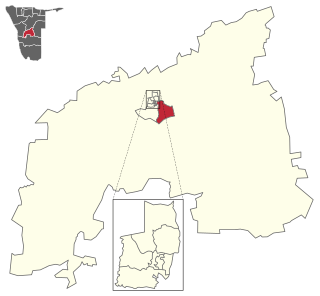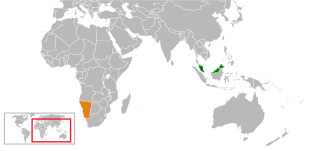Related Research Articles

Windhoek is the capital and largest city of Namibia. It is located in central Namibia in the Khomas Highland plateau area, at around 1,700 m (5,600 ft) above sea level, almost exactly at the country's geographical centre. The population of Windhoek, was 486,169 in 2023, is constantly growing due to a continued migration from other regions in Namibia.

Khomas is one of the fourteen regions of Namibia. Its name refers to the Khomas Highland, a high plateau landscape that dominates this administrative subdivision. Khomas is centered on the capital city Windhoek and provides for this reason superior transportation infrastructure. It is located in the central highlands of the country and is bordered by the Erongo region to the west and the northwest and by the Otjozondjupa region to the north. To the east is the Omaheke region, while in the south is the Hardap region. The region is characterized by its hilly countrysize and many valleys. It has well-developed economical, financial, and trade sectors. Khomas Region occupies 4.5% of the land area of Namibia but has the highest population of any of its regions (16.2%). Khomas is one of only three Namibian regions to have neither shoreline nor a foreign border.

Windhoek East is a constituency in the Khomas Region of Namibia. It consists of the upper-class suburbs of Windhoek: Auasblick, Avis, Klein Windhoek, Ludwigsdorf, Luxury Hill, Olympia, and Suiderhof. It had a population of 22,712 in 2011, up from 17,674 in 2001. As of 2020, it has 17,308 registered voters.
Okahandja is a city of 45,159 inhabitants in Otjozondjupa Region, central Namibia, and the district capital of the Okahandja electoral constituency. It is known as the Garden Town of Namibia. It is located 70 km north of Windhoek on the B1 road. It was founded around 1800, by two local groups, the Herero and the Nama.

The Namibia Cricket Board, known commercially as Cricket Namibia, is the official governing body of the sport of cricket in Namibia. Its current headquarters is in Windhoek, which is the capital and largest city of Namibia. Cricket Namibia is Namibia's representative at the International Cricket Council and has been an Associate Member of that body since 1992. It is also a Member of the African Cricket Association.

Namibia–South Africa relations refers to the current and historical relationship between Namibia and South Africa. South Africa captured the area now known as Namibia from Germany during World War I and governed it, by the name 'South West Africa', until 1990, when the country gained independence under the name 'Namibia'. During those 75 years, thousands of South Africans settled in the territory and South Africa treated the area as effectively a fifth province of both the Union and the Republic, imposing apartheid laws in South West Africa as it did in South Africa.

Namibia–Russia relations are the bilateral relations between Namibia and Russia. Namibia has an embassy in Moscow and Russia has an embassy in Windhoek. Samuel Mbambo is the Namibian representative in Moscow, while Russia is represented in Windhoek by Nicolai Gribkov.

The Supreme Court of Namibia is the highest court in the judicial system of Namibia. It is the court of last resort and the highest appellate court in the country. It is located in the city centre of Namibia's capital city, Windhoek. A Supreme Court decision is supreme in that it can only be reversed by an Act of Parliament that contradicts it, or by another ruling of the Supreme Court itself.
Prostitution in Namibia is legal and a highly prevalent common practice. Related activities such as solicitation, procuring and being involved in the running of a brothel are illegal. A World Bank study estimated there were about 11,000 prostitutes in Namibia.

Namibia–United Kingdom relations are the bilateral relations between Namibia and the United Kingdom. Both countries are members of the Commonwealth of Nations and the United Nations.

Namibia is an arid country that is regularly afflicted by droughts. Large rivers flow only along its northern and southern borders, but they are far from the population centers. They are also far from the country's mines, which are large water users. In order to confront this challenge, the country has built dams to capture the flow from ephemeral rivers, constructed pipelines to transport water over large distances, pioneered potable water reuse in its capital Windhoek located in the central part of Namibia, and built Sub-Saharan Africa's first large seawater desalination plant to supply a uranium mine and the city of Swakopmund with water. A large scheme to bring water from the Okavango River in the North to Windhoek, the Eastern National Water Carrier, was only partially completed during the 1980s.

Namibia is a multilingual country in which German is recognised as a national language. While English has been the sole official language of the country since 1990, in many areas of the country, German enjoys official status at a community level. A national variety of German is also known as Namdeutsch.

Malaysia–Namibia relations refers to bilateral foreign relations between Malaysia and Namibia. Malaysia has a high commission in Windhoek, and Namibia has a high commission in Kuala Lumpur. Both countries are members of Commonwealth of Nations and the Group of 77.

Kenya– Namibia relations are bilateral relations between Namibia and Kenya.
The COVID-19 pandemic in Namibia is part of the worldwide pandemic of coronavirus disease 2019 caused by severe acute respiratory syndrome coronavirus 2. The Minister of Health and Social Services, Kalumbi Shangula, announced on 14 March 2020 that the virus had reached Namibia. A Romanian couple constituted the two first cases and recovered 79 days after their initial diagnosis.

Squatting in Namibia is the occupation of unused land or derelict buildings without the permission of the owner. European settlers arrived in the nineteenth century and acquired land, leaving only 38 per cent of land in indigenous hands by 1902. This led to squatting and the Herero Wars, which ended with the Herero and Namaqua genocide. After Namibian independence in 1990, squatting increased as people migrated to the cities and land reform became a goal for those who had participated in the liberation struggle. By 2020, 401,748 people were living in 113 informal settlements across the country. Squatting continues to be regulated by the Squatters Proclamation of 1985; a challenge to this law was dismissed by the High Court in 2023.